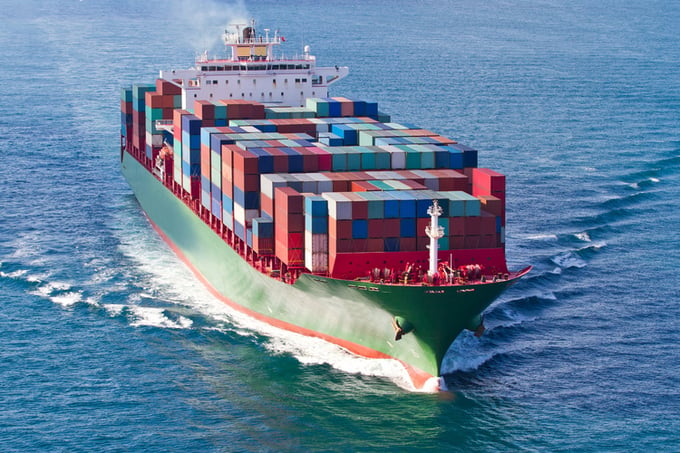DHL says ocean freight rate inflation might not ease up before Chinese New Year in early 2025, with some forecasts seeing rates reaching to between $20,000 and a Covid era peak of $30,000.
Longer Red Sea transits resulting in a shipping container capacity shortage and canceled sailings from Asia are stoking spot ocean freight rates.
Demand alone cannot explain the price hikes, with ocean freight orders down 48% month over month.
Just as the Federal Reserve and U.S. economy get good news on inflation, with consumer prices and wholesale prices softening, a major global trade inflation indicator is headed in the wrong direction. Rising freight rates are a new source of concern in the global supply chain with forecasts warning that ocean cargo prices could reach $20,000 — potentially even touch the Covid era peak of $30,000 — and stay there into 2025.
Spot ocean freight rates from the Far East to the U.S. popped between 36%-41% month over month, and ocean carriers increased additional charges known as general rate increases by roughly 140%, according to the CNBC Supply Chain Heat Map. These costs have taken the price of a 40-foot cargo container to about $12,000.
“This index data confirms what we are seeing from our data and hearing from shippers,” said Paul Brashier, vice president of global supply chain for ITS Logistics. A lack of containers and limited vessel capacity overseas has forced shippers to move to the spot market to find equipment to load out at origin. “That is significantly driving rates to levels not seen since the post-Covid crisis two years ago,” he said. Freight is also bottlenecked at port terminals due to extended dwell times and empty containers to load with goods are very scarce, Brashier added.
Goetz Alebrand, head of ocean freight at DHL Global Forwarding Americas, said he is not optimistic freight rates will decline anytime soon.
“It is unlikely that the situation will resolve itself soon and [ocean freight] rate levels might not ease up before Chinese New Year,” Alebrand said.
Testing the peak Covid era $30,000 container rate
On Thursday, Sea-Intelligence issued a note forecasting that Asia-Europe spot prices could exceed $20,000, with the Red Sea crisis — the Houthi rebels have been stepping up attacks on ships recently — and the increase in nautical miles traveled need to be factored in.
“The pandemic set a precedent, which is that during times of severe distress, freight rates per nautical mile can reach these very high levels,” said Alan Murphy, Sea-Intelligence CEO.
According to the Defense Intelligence Agency’s report on the economic impact of the Houthis’ Red Sea attacks, container shipping through Red Sea had declined by approximately 90% between December 2023 and mid-February. Alternate shipping routes around Africa not only add about 11,000 nautical miles (one to two weeks of transit time), but also add an approximate $1 million in fuel costs for each voyage.
Sea-Intelligence data estimates that if the rate paid per nautical mile reaches the same level as during the pandemic, spot rates will reach $18,900 per forty-foot container from Shanghai to Rotterdam, $21,600 per forty-foot container from Shanghai to Genoa, and $21,200 per forty-foot container on the back-haul from Rotterdam to Shanghai also is possible. “Spot rates will continue to rise as long as there are enough shippers willing to pay the price,” said Murphy. “This means that although it is unlikely that the spot rates will increase beyond the levels of the pandemic period, it is by no means a guarantee.” He said on the Transpacific route (Asia to the U.S. West Coast/East Coast), the extrapolation of the maximum spot rate would be identical to the pandemic period, when some rates reached $30,000 per container.
Peter Boockvar, chief investment officer at Bleakley Financial Group, said the global economy is in a new world of inflation volatility, even as the Fed’s latest comments and Consumer Price Index data in the U.S. showed progress on disinflation. “The spike in ocean shipping rates, along with air is a reminder of this,” Boockvar said. “We’ve seen in the past goods prices can easily be reversed upward. Higher for longer rates are real.”
Shippers are frustrated by the sharp turn in supply chain pricing. Nate Herman, senior vice president of policy at the American Apparel and Footwear Association, wrote in an email that in May the market saw low demand, with container bookings down 48% and ample supply with vessel capacity up 2.6%, “but yet carrier general rates exploded with up to a 140 percent increase! Shippers are paying sky-high rates as a direct result of schemes that ignore existing contracts.”
Air freight prices and demand are going higher
According to freight intelligence firm Xeneta, China to North America air freight spot rates increased 43%, to $4.88 per kilogram, year-on-year in May. Global air cargo spot rates were up 9% year-on-year in May, to $2.58 per kg.
Increased demand is a factor in the air freight market. In a recent note to clients, Xeneta wrote that the global air cargo market is “on a pathway to double-digit growth in volumes in 2024, after a +12% year-on-year jump in demand in May.”
Companies from Apple
to Chinese retailers Temu and Shein, as well as semiconductor companies, use air freight as the top choice for transporting products.
If the costs keep up through the end of the summer, then this will put upward price [pressure] on Apple and chip products passed on to the end user and consumer,” said Daniel Ives, managing director and senior equity analyst at Wedbush Securities. “This is heading into a key time as iPhone 16 ramps heading into the mid-September timeframe.”
Niall van de Wouw, Xeneta chief airfreight officer, told CNBC that air cargo spot rates from China to the U.S. have surged in 2024, primarily due to the extraordinary boom in e-commerce demand through companies such as Shein and Temu.
“We may also be seeing some impact on air freight due to disruption in ocean container services,” said van de Wouw. “Given that 98% of the world’s cargo is moved by ocean, even a percentage shift of 0.2% would see a 10% increase in air freight volumes. This illustrates how sensitive air freight can be to disruption on the oceans.”
While global spot rates were up 9% in May year-over-year, he said not all the world’s major trade routes are seeing this level of spot rate increases. Trade from Europe to North America saw a rate decline of 21%.
The CNBC Supply Chain Heat Map highlights the disconnect between ocean freight prices and demand, which is unlike during the pandemic when ocean freight was fueled by insatiable consumer buying and a lack of containers and vessels to move the trade.
According to ocean freight data from FreightWaves SONAR, container bookings and freight orders from shippers to the ocean carriers are down 48% month-over-month. Ocean carriers are canceling vessel sailings and around 37% of ocean bookings, which creates a tighter market for containers to be placed on vessels, increasing the price of the container. Adding to the constriction of container availability are the longer Red Sea transits. The route around the Cape of Good Hope ties up container availability and artificially shrinks the pool of available containers.
Xeneta data tracking ocean freight rates from the Far East to the U.S. East Coast, West Coast and Gulf Coast ports shows the historic run.
“There is evidence of smaller ocean carriers repositioning vessels and charters being booked to capture this higher revenue,” Brashier said. He said this could create two significant challenges which his company is keeping a close eye on. First, there will be significant amounts of containers entering North America across a greater number of ships and through ports that shippers are not accustomed to, and the higher total number of ships bringing in cargo through traditional gateways will overwhelm current supply chain operations.
Port delays create a “bunching” effect similar to vessel arrivals that led to port congestion during the pandemic. In a recent note to clients, DHL warned of the continued port congestion at key China and Southeast Asia ports. Singapore has been smacked with congestion for weeks, with vessels waiting on average seven days to get into port. DHL said waiting times have also risen across all main Chinese port regions, with Shanghai and Qingdao experiencing the longest delays.
According to container shipping market intelligence company Linerlytica, the worsening port congestion has immobilized approximately 2 million TEU of ships, nearly 7% of the fleet.
Brashier said this could create significant challenges for shippers: navigating the large amount of peak season containers entering North America earlier on a greater number of ships could create port congestion. The entrance of smaller vessels adds to congestion at the ports.
“Are we operating in a Covid-like environment without the actual presence of Covid? It certainly feels that way. Several niche carriers have recently entered the market,” Jon Monroe of Jon Monroe Consulting wrote in a recent advisory about smaller carriers entering the market offering expedited services.
DHL recommends clients pre-booking their freight four to six weeks before their scheduled departure to reduce the chances of having the freight rejected and ensure timely and efficient service.
East Coast, Gulf Coast strike concerns
West Coast prices could rise more with the suspension of contract talks between the International Longshoremen’s Association, which represents union workers at East Coast and Gulf Coast ports, and the United States Maritime Alliance (USMX), which represent the ports. Fears of an ILA strike in the fall motivated logistics managers to move up the timeframe of importing holiday goods earlier this year to ensure the items are in warehouses before the September 30 contract deadline.
In a new statement on Wednesday, ILA President Harold J. Daggett warned, “The threat of a coast-wide strike on October 1, 2024, is becoming more likely as USMX and its member companies continue to drag their feet.”
But according to Gene Seroka, executive director of the Port of Los Angeles, it has only seen a fractional amount of containers diverted to its port to mitigate multiple risks, from the Red Sea to the Panama Canal drought and ILA/USMX negotiations. The port’s May container imports were down 3% year over year, while exports hit a new milestone of 12 consecutive months of gains. “We have heard nothing since this announcement,” Seroka tells CNBC. “During these negotiations, there are stops and starts and I don’t see this as terribly unusual.”
Talks were suspended this week over union allegations that Maersk and its APM Terminals were using automation in violation of the master contract. “Companies like Maersk are repeatedly trying to eliminate ILA jobs with the introduction of automation while realizing raking in billions of dollars,” Daggett said. “They are in for a rude awakening. This is our time, and the ILA will demand our ILA longshore workers get big boosts in their wages.”
Maersk said in a statement that it remains in full compliance with the ILA/USMX master contract and said it was “disappointed that the ILA has chosen to make selected details of ongoing negotiations public in an effort to create additional leverage for their other demands.” Maersk said it will continue to engage with all stakeholders, including the ILA, to address their concerns.
Appearing at the Port of Los Angeles, Jared Bernstein, chair of the United States Council of Economic Advisers, said the Biden administration is carefully watching the port union negotiations because of the impact a strike can have on the economy and it is encouraging both sides to negotiate in good faith.
“It is the policy of our administration to encourage collective bargaining because we know it works,” said Bernstein. “The president knows that it works. He is the first president to actually walk the picket line. He always supports collective bargaining, but he also supports giving the parties and the space they need, when they’re at this stage and association.”

 Tiếng Việt
Tiếng Việt




